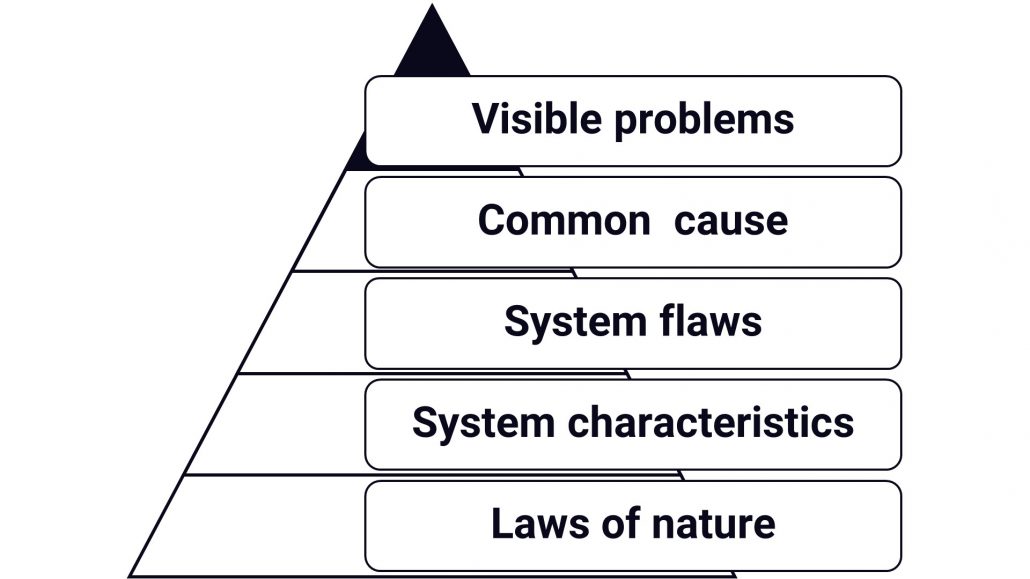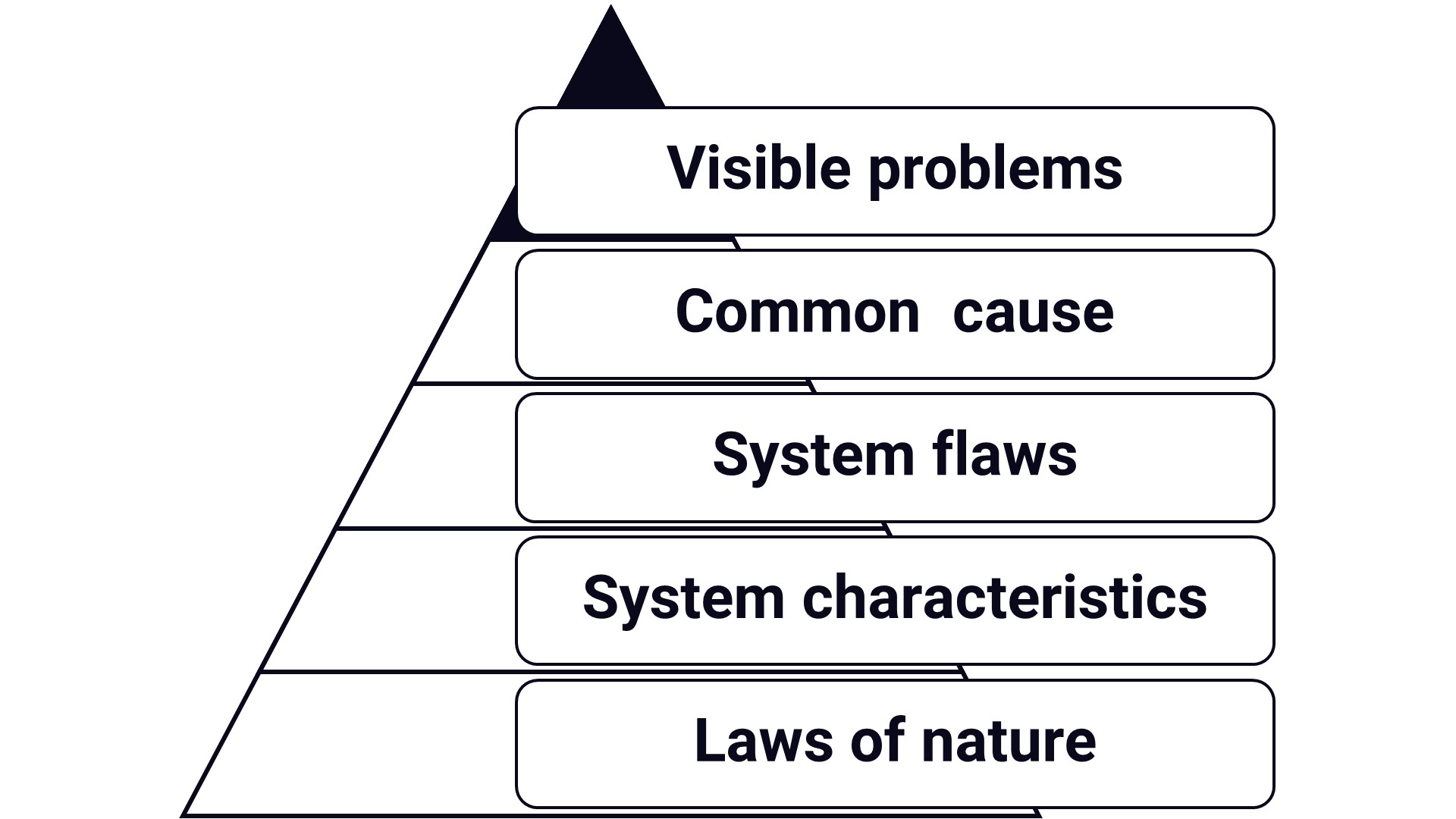Why projects fail?
This is a response to a facebook post of Elyakim Schragenheim and Sanjeev Gupta, to discuss the basic structure of the Theory of Constraints.
https://www.facebook.com/groups/6230904187/permalink/10156895619249188/
The Hierachy of Manifestation (of projects) is a structure to analyse project organizations and the flaws that cause problems. Project organizations are complex, and difficult to determine what to do become better in project management. The hierarchy of manifestation shows that projects and project organizations are exceedingly simple.
The attempt to creating structure is a great initiative. Structure seems to be the prerequisite to share understanding. It helps people, to learn complex matters more easily. Structure creates a common vocabulary. It helps practitioners to understand each other. And structure is the stair case to climb on the shoulder of giants.
Creating structure for the Theory of Constraints, is a topic of conversation for many years already. It seems an attempt to discover its identity. What is the Theory of Constraints? Why does success remain limited to a few great success stories? Why does everyone use Lean and Agile, while Theory of Constraints remains a curiosity or completely unknown?
I’ve studied the article of Sanjeev and Eli carefully. I’ve only expertise in the world of projects. My response will be restricted to this domain only.
I’m involved in projects since early 90’s. I’m a certified project manager. I got the opportunity to look behind the scenes of many different organizations in different industries. I read the goal around 1997. I’ve been involved in a few CCPM implementations. I’m passionate about projects.
When I started researching project organizations about 7 years ago I had almost 25 years of experience in projects. I thought I knew pretty well how they work. But I couldn’t be more wrong. I was totally wrong. There were many secrets nobody ever told me about I needed to unlock to learn even the basics of project management. It is not what it looks like. Project management looks complex initially, but is exceedingly simple.
I used structures as a stair case to enhance my view and to observe the manifestation of the world from new perspectives.
TOC is a solution to better understand the world (of project organizations). But what exactly is it that we need to understand better?
Allow me to step away from the TOC and CCPM concepts to create a structure to fit in TOC. I introduce a structure that I call the Hierarchy of Manifestation. It is about how (project) organizations can be observed by their appearance (manifestation), or by the perception by people, or how they demonstrate cause effect relations and patterns of operation. A structure based on manifestation is helpful, because it enables to constantly check assumptions and interpretations with concrete situations in project organizations.

The hierarchy consist of 5 separate distinct layers. The top covers observable problems. These are the problems that people complain about. These are the problems that organizations take initiatives on to fix.
I discovered the hierarchy of manifestation top down, but I will discuss it bottom up.
Laws of Nature
The foundation of the hierarchy represents the laws of nature. These are the rules that can’t be broken. It is the world of science. The layer of logic of cause and effect. Chemistry. Physics. Biology. I remember when I discovered that the drivers for evolution of life apply to project organizations to. It is a rule of nature that specific molecules are released in the human brain that disables logical thinking under circumstances that are common in project organizations. It is a law of nature that the capacity of the human brain is limited. It is law of nature that thinking is an unpredictable stochastic process. It is a rule of nature that work must be done in a specific order to create results. It is a rule of nature that basic needs that must be fulfilled to complete projects successfully and to stay out of problems.
Phenomena from systems theory and insights from ToC as rules of nature. Like the concept of the constraint. Or the phenomenon that most problems in systems have one common cause.
No solution or action ever can break the rules of nature. Many improvement initiatives fail because they try to break rules that can’t broken.
Which laws apply is determined by the system we want to analyze. It is different for a black smith as for a hospital.
System Characteristics
The second layer of the manifestation is about the system we build to achieve our goals. For projects this is about the system we create to achieve goals for which we must use projects. Projects have big, greater and limitless ambitions than we achieve alone. The ambitions of projects are too big to figure out the roadmap for, by ourselves with our eyes closed and without means for documentation. The ambitions are often bigger than there is capacity for.
Finite resources can’t guarantee there is always enough capacity to supply every demand.
So, systems are needed to secure capacity. Systems are needed to collaborate and to think beyond the limitations of the human brain. These systems involve people, paper, writing, IT systems, knowledge base like PMBoK, methodologies like Prince2, competencies defined by IPMA, standards like ISO 21500, organizations, ways to collaborate, processes, partnerships, digital task boards, planning software, disciplines, solutions to deal with complexity and uncertainty. This second layer holds many other characteristics that apply to project organizations like the complexity, the need for thinking work, high levels of uncertainty and the necessity to for frameworks, methods, and best practices. Many of these characteristics are generic for project organizations.
The purpose of the system is to achieve the goals. For project organizations to complete projects successfully and to stay out of problems.
System Flaws
The third layer of manifestation is how project organizations manifest through flaws in the system that get in the way of achieving the goals. The purpose of the system is to complete projects successfully and to protect from running in trouble. The rule of nature is that basic needs must be fulfilled. The system isn’t running flawless. That means that there must be unfulfilled basic needs.
- Project organizations can’t prevent more projects get started than for which the basic needs can be fulfilled. The project management community hasn’t been able to supply organizations proper solutions. This is probably the biggest flaw of project organizations.
- Project management frameworks and methods are too complex and too difficult to learn for many project managers. And too cumbersome to execute. Just a minority of the project managers have knowledge of the frameworks and methods. Only a fraction of the project managers knows how to execute the processes carefully.
- Project management frameworks and methods have no processed dedicated to fulfilling basic needs.
- Project organizations are supposed to create optimal and safe work environments but disable people to execute their work. The typical working conditions in project organizations lead to stress and fear. Stress and fear disable concentrated cognitive thinking, which is the core of project work.
Common Cause
The forth layer is the manifestation of the common cause. The common cause is the reason why projects don’t get completed successfully and why projects run in problems. This is exactly what defines the basic needs. Preventing this from happening is the purpose of basic needs. So, the common cause must be unfulfilled basic needs. What exactly those unfulfilled basic needs are, depends on the laws of nature and the characteristics of the system. For projects across the world, which share the same generic system characteristics, 4 specific basic needs must be fulfilled all the time. I’ve been able to confirm each unfulfilled basic need in the organizations I analyzed through how project organizations manifest. People complain about it massively, but in stead of blaming the system, they blame each other.
I’ve published a project management guideline that is focusing on fulfilling the basic needs only. It contains a brief explanation about what those basic needs are. This guideline is available for download for free.
Note that I articulate the common cause in terms of unfulfilled basic needs instead of high WIP or multitasking. The law of nature is that basic needs must be fulfilled to complete projects successfully and to stay out of problems. Low WIP and absence of multitasking aren’t.
Fixing the flaw must lead to fixing the common cause. And the other way around, fixing the common cause implies that the flaws have been fixed. That is true for unfulfilled basic needs. It isn’t necessarily true for high WIP and multitasking. The difference might result is similar but also very different measures. Without understanding the difference, I wouldn’t be able to fix the flaws the way I did and write the basic guideline for project managers.
Visible Problems
The hierarchy of manifestation is concluded by the visible problems that are typical for project organizations. I’ve analyzed hundreds of problems that fit in this structure. Almost all can be traced back to the common cause. My research started with pinning a brown paper on the wall to create a CRT. So, the way I conducted my research started top down, and with the identification of one of the 4 basic needs. Through drilling down, I learned there must be 4 basic needs that apply to all projects. These needs are the definition of what projects are.
Projects are works that take time of people to create the products and to collaborate with each other to align the work, to overcome obstacles and to solve problems, for which a documented plans are needed, that determines what to do and what to do next to create the product and that constantly need to be adapted to absorb change and uncertainty.
I like to thank Sanjeev and Eli for taking the initiative for this discussion and raising new questions in my head.
